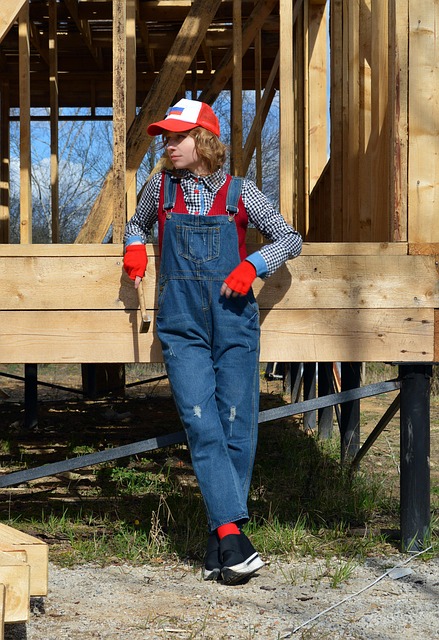Residential foundation stabilization is crucial for protecting homes' structural integrity and longevity. Environmental factors like soil conditions, age, and weather cause issues like cracks, uneven floors, and misaligned doors. Various Foundation Solutions – from underpinning to piering – address these problems, ensuring homes remain stable. Regular evaluation, early identification of damage, and consultation with professionals are vital for maintenance. By understanding environmental impacts and implementing preventative measures, homeowners can utilize effective Foundation Solutions to maintain safe, secure living spaces.
Residential foundation stabilization is a critical aspect of home maintenance, addressing issues that can compromise structural integrity. This comprehensive guide explores various aspects of ensuring your home’s foundation remains stable. From understanding the basics and identifying common causes of instability to modern techniques like piering and bracing, we cover it all. Learn about environmental factors affecting foundations and long-term strategies for prevention, empowering you with the knowledge to implement effective foundation solutions.
Understanding Residential Foundation Stabilization: The Basics

Residential foundation stabilization is a critical process that ensures the structural integrity and longevity of homes. It involves addressing any issues related to the foundation’s stability, which can be affected by various factors like soil conditions, age, and environmental changes. By understanding these basics, homeowners and professionals alike can grasp why it’s essential to consider foundation solutions early on.
The primary goal is to mitigate potential risks such as cracks in walls or ceilings, uneven floors, and door or window misalignment. Foundation stabilization techniques range from non-invasive methods like underpinning and chemical soil stabilization to more intensive approaches like piering and underpiling. These solutions not only restore stability but also prevent future damage, ensuring the home remains a safe and secure living space for years to come.
Common Causes of Foundation Instability and Damage

Foundation instability and damage are often the result of various environmental factors and structural issues. One of the primary culprits is excessive moisture, which can lead to soil expansion and contraction, putting immense pressure on the foundation. This process, known as heave and settle, causes cracks in the concrete and can misalign doors and windows. Another common cause is poor initial construction, including inadequate footing or improper drainage systems, which can compromise the structural integrity of a home over time.
Additionally, shifting soil due to poor compaction or nearby excavation projects can cause significant foundation problems. Tree roots also play a role; their growth can lead to uneven soil removal, resulting in foundation movement. Foundation solutions often involve addressing these issues through methods like piering, which involves installing steel piers to support the foundation, or mesh wall systems that reinforce the soil around the structure.
Advanced Foundation Solutions: Modern Techniques for Stabilization

In the realm of residential foundation stabilization, advanced foundation solutions have emerged as game-changers, offering modern techniques to address structural challenges. These innovative methods go beyond traditional approaches, leveraging cutting-edge technologies and strategies to ensure long-term stability and longevity for homes. One such technique involves underpinning, where additional support is added below the existing foundation to distribute weight more evenly and prevent further settling or shifting.
Another contemporary approach is the use of pile foundations, which consists of driving steel piles into the ground to bear the load of the structure. This method is particularly effective for properties built on soft or unstable soil, providing enhanced stability and protection against differential settling. Additionally, modern polymeric injection materials can be used to fill voids and strengthen existing foundation walls, offering a cost-effective and efficient solution for various foundation issues.
Evaluating Your Home's Foundation: Identifying Problems Early

Evaluating your home’s foundation is a crucial step in ensuring its stability and longevity. As part of regular maintenance, inspect visible signs of damage or settlement, such as cracks in walls, uneven floors, or doors that stick. These could indicate issues with soil conditions, structural problems, or poor initial construction, all of which can be addressed through various foundation solutions.
Early identification of foundation problems is key to preventing further deterioration. Regular assessments allow for proactive measures, saving you from costly repairs later. By consulting with professionals who offer foundation solutions, you can gain insights into the health of your home’s foundation and implement necessary stabilization techniques, securing a solid base for your residence.
Piering, Bracing, and Other Structural Support Methods

When it comes to residential foundation stabilization, piering and bracing are effective foundation solutions that address structural issues. Piering involves installing vertical supports, often made of concrete or steel, at strategic points beneath the structure. These piers act as additional load-bearing elements, distributing the weight of the building evenly and preventing settlement or shifting of the foundation. This method is particularly useful for older homes with weak foundations or areas prone to earthquakes or heavy rainfall.
Bracing, on the other hand, uses horizontal support beams or rods to reinforce the foundation. It’s a common solution for houses with bowing walls or tilted floors. By applying lateral pressure, bracing helps stabilize the structure and prevent further damage. Together, these foundation solutions offer comprehensive reinforcement, ensuring the longevity and structural integrity of residential properties in various environmental conditions.
Foundation Leveling: When and Why It's Necessary

Foundation leveling is a crucial aspect of residential foundation stabilization, often necessary due to settling or uneven soil conditions. Over time, foundations can shift and settle unevenly, leading to cracks in walls, uneven floors, and door jams that don’t close properly. This is typically caused by factors like poor soil compaction, tree root disturbance, or changes in hydrology, among others.
When these issues are left unaddressed, they can result in significant structural damage. Foundation leveling solutions, offered by professional foundation experts, involve using specialized equipment to jack and stabilize the foundation back to its original position. This process not only corrects the structural problems but also prevents further deterioration, ensuring the longevity and safety of the home.
The Environmental Impact on Residential Foundations

The environmental conditions play a significant role in the stability and longevity of residential foundations. Factors like soil composition, moisture levels, and weather patterns can exert considerable pressure on structures, leading to potential foundation damage over time. For instance, regions with expansive clay soils are prone to swelling and shrinking, causing cracks and misalignments that require foundation solutions to rectify. Similarly, areas with high water tables or frequent rainfall can contribute to soil erosion and moisture intrusion, compromising the integrity of foundations.
Understanding these environmental influences is crucial for implementing effective foundation stabilization measures. Professional assessment and tailored solutions, such as those offered by foundation experts, can address specific challenges. By utilizing advanced techniques and materials, these specialists create durable and reliable foundation support systems, ensuring homes remain stable and secure despite varying environmental conditions.
Long-Term Maintenance and Prevention Strategies for Stable Foundations

Maintaining a stable residential foundation is an ongoing process that requires long-term strategies. Regular inspection and maintenance are key to preventing future issues. One effective approach is to implement a comprehensive monitoring system, including periodic assessments by professional structural engineers. These experts can identify subtle signs of instability or shifting soil conditions early on, allowing for prompt action.
Prevention also involves addressing potential water infiltration issues, as moisture can weaken the foundation over time. Effective drainage solutions and sealing vulnerable areas can significantly extend the lifespan of your foundation. Additionally, regular re-leveling and adjustment of any uneven floors or walls can help maintain structural integrity. By combining these proactive measures with routine maintenance, homeowners can ensure their foundations remain stable for years to come, thus avoiding costly repairs and promoting a safe living environment.
